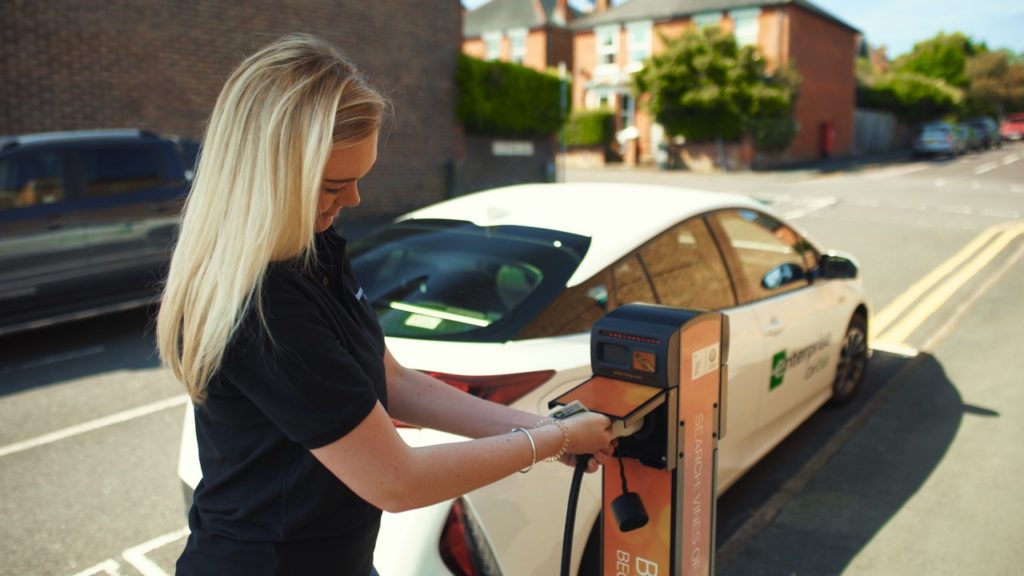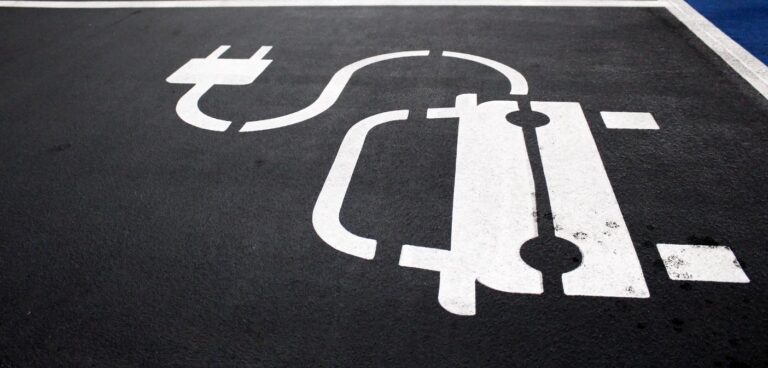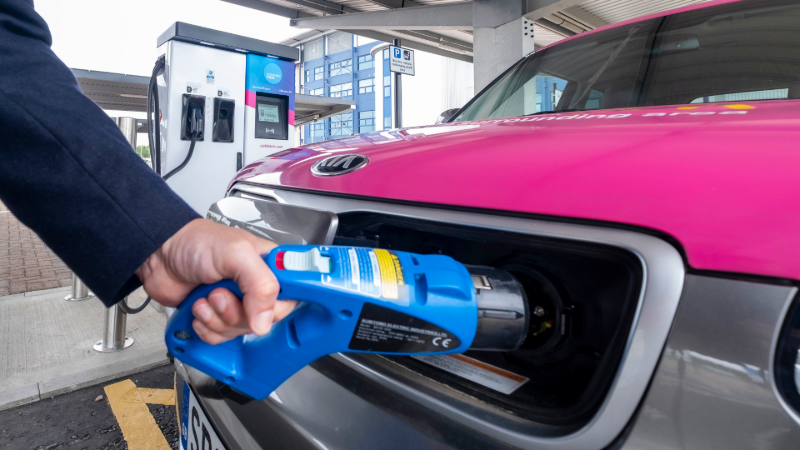Katie Searles questions the role of local authorities in delivering EV charging infrastructure…
According to the latest UK Department for Transport (DfT) electric vehicle (EV) charging device statistics, released in January 2022, there is an uneven geographical distribution of charging devices within the UK. For example, Northern Ireland has the lowest level of provision, with 18 devices per 100,000 of population, followed by England’s North West and Yorkshire/Humber regions, with 24 and 26 devices per 100,000, respectively. In comparison, London recorded the highest level of EV charging provision with 102 devices per 100,000.
Within its breakdown of regional distribution of charging devices, the DfT states that “some local authorities have bid for government funding for charging devices and others have not, while most of the provision of this infrastructure has been market-led, with individual charging networks and other businesses, such as hotels, choosing where to install devices”.
But given that local authorities are tasked with delivering local EV charging been market-led so far? Is a lack of public sector leadership to blame for the uneven geographical distribution of charging devices within the UK?
“Up to now, infrastructure decisions have been developed with individual drivers and private use cases in mind,” says Gerry Keaney, chief executive of the British Vehicle Rental & Leasing Association. “This needs to change so we are providing local authorities with the tools they need to succeed.”
Jo Wall, strategic director – climate response at Local Partnerships, a joint venture between the Local Government Association, HM Treasury and Welsh government, attributes the lethargy to a lack of a demand: “There has been some public sector rollout for the better part of a decade, in trial projects and pilots, but local authorities aren’t seeing sufficient consumer demand in their area to actually do that much.”
This concerns Andrew Merritt-Morling, CEO of net zero consultancy Smart Cities Connections, who feels that “an environment where suppliers have the upper hand puts the delivery of best value at significant risk”. Instead, he would like to see the government provide policy frameworks for local authorities to “hang their solutions on”. Such guidance could also assist local authorities ‘funnel funding’ effectively, a task that has been compounded by Covid-19, believes Iain Macbeth, director of electric vehicle strategy for Enterprise.
According to Macbeth, local authorities already had “a lot on their plates” before the need to respond to a global pandemic, with focuses on health, education and social services all competing for constrained taxpayer funding. “Local authorities only have certain revenue streams to allocate to transport, and this must include all forms of transport, with active travel currently high on the post-pandemic agenda. Clearly, EVs are not at the top of that transport hierarchy,” he says.
Merritt-Morling believes that local authorities know there is a need to act, but the scale is not fully understood. He says: “The roles for different types of local authority are not clear, and the mechanism for resource allocation and distribution of funding requires proper consideration and succinct communication. Access to finance and capacity building are the biggest barriers to delivery and it will be constraints in these areas that are driving decision-making for local authorities.”

More stick, less carrot?
As the latest Df T statistics suggest, only some local authorities have bid for infrastructure funding. And as provision at the local level is installed at the discretion of local authorities, the public sector’s apparent profligacy has led the UK Office for Zero Emission Vehicles (OZEV) to go as far as to consider imposing a statutory duty on councils in England and Wales to plan and deliver for EV infrastructure. The move is part of a review of the zero-emission vehicle landscape, which could introduce a raft of new legislation and regulations to support EV uptake.
This includes a statutory obligation to plan for and provide charging infrastructure as well as requirements to install chargepoints in non-residential car parks. It would also see new powers given to support the delivery of the Rapid Charging Fund, which OZEV says “will ensure that there is a sufficient charging infrastructure and appropriate consumer protections in place to meet the needs of electric vehicle drivers”.
But is this the right approach? Merritt-Morling believes local authorities are already resource-constrained and thus the creation of any new burdens would need to be accompanied with new resources, both revenue and capital. “Whilst imposing a statutory duty on local authorities to plan and deliver EV infrastructure might lead to faster deployment, targets would need to consider the nature of place and be targeted at specific types of interventions,” he notes.
He suggests that central government needs to ensure that local authorities are properly equipped and incentivised, including support to fund dedicated expertise – something local authorities may be missing currently, according to Wall. “It’s an area that councils don’t necessarily naturally have skills in. They have transport planning skills, they understand the process, but energy networks are something that, until fairly recently, wasn’t really on their radar,” she says.
“Even in strategic planning councils don’t necessarily look at the power requirements and whether the infrastructure can serve what they’re putting into their spatial plans,” continues Wall. “They’re finding some of those interfaces quite challenging when they try to do projects. They’re quite resource intensive.”
Knowledge gap
This lack of lack of utility knowledge may explain why more than half of all UK councils have either yet to implement an EV transition strategy for their f leet or even start a transition strategy already mapped out. The data behind this startling claim comes from a report based on a freedom of information request, sent in November 2021 by Smart Cities Connections, to which 295 local authorities across England, Scotland, Wales and Northern Ireland responded – a further 88 councils did not provide data.
And of those 295 councils, almost one-in-five (19%) said they have no EV strategy planned, with a further 104 councils (37%) having transition strategies planned but not started. These councils collectively operate some 67,234 vehicles and, of that total, 8,231 belong to local authorities that have no EV transition strategy in place. In addition to a lack of utility knowledge, could expense be another barrier?
“More than half of local authorities surveyed by the Electrical Contractors Association cited electric vehicle charging points as being prohibitively expensive to install,” says Merritt-Morling. “UK councils received 15% less funding from the government for EV charging infrastructure in the last 12 months than in the same period in 2020. The average cost of a council-bought chargepoint in the UK is £6,000, although figures range between £350 and £100,000 depending on a number of factors.”
Additionally, as council fleets tend to operate cars, LCVs, trucks, buses, coaches and two-wheelers, Wall cites the sheer range of vehicles used by local authorities as another sticking point. “It is not as simple as changing to an electric car, it’s about assembling a resource jigsaw – by getting enough of the right people behind the transition, the better councils will get at it. Through electrification of their own f leet vehicles, local authorities can in turn help build trust in the sector, which will create a snowball effect.”

Powering on
One city that appears to have put together the right ‘resource jigsaw’ is Coventry, which has the highest number of public EV charging points per head of population outside of London. Currently standing at 460 charging points, this number is expected to rise to 860 by 2023. “Coventry is an example of what you can do if you want to, the city council there is quite a proactive local authority,” says Wall.
In addition to Coventry City Council’s work driving EV charging infrastructure, both Coventry University and the University of Warwick are helping to create an environment that, as Wall describes, “would make you want to do things in one place”. It’s why the region could soon be home to a Gigafactory at Coventry Airport. The 530,000m2 facility, expected to be ready in 2025, will manufacture high-tech lithium-ion batteries for the global automotive and energy storage industries.
Such a development will be integral to the UK’s EV rollout, says Macbeth, before warning that power is a problem that remains to be addressed. In an electric future where conventional fossil fuel forecourts are replaced with EV charging hubs, similar to facilities already open in Fulham, London and Braintree, Essex, Macbeth stresses that getting the required power to those locations will be a significant local authority responsibility.
He compares the UK’s EV infrastructure rollout to digital inclusion and access to fibre fast broadband. To ensure no communities are left behind, Macbeth explains that there needs to be a collaborative approach and suggests that the next three years are “absolutely critical” for infrastructure deployment.
“Local authorities are getting the toolkits and directive to do things, but some of that direction needs to come higher up the tree,” he says. “Some of these constraints that we see today are things that perhaps should have been thought about earlier – whether that’s the national grid and supply-chain business plan not necessarily being aligned with the rollout of EVs and targets from central government.
“They have not prioritised investment in a network that has been measured on the ability to keep the lights on. There needs to be a step change now and there has to be encouragement to invest in the network to make sure power is available,” Macbeth concludes.
The Scottish route
While the rest of the UK has opted for a private-public funding model, the Scottish government has invested £50m into a network of public charging points. Since 2013, ChargePlace Scotland has delivered 2,100 charge points ‘from Shetland to Stranraer’, which has resulted in the number of charging points ‘north of the boarder’ outnumbering much of the UK, with the exception of London.However, if Scotland is to achieve its climate targets – a 75% reduction in greenhouse gas emissions by 2030 and to achieve net zero by 2045 – it needs to rapidly increase the number of public chargepoints. And like its southern neighbours, local authorities will play a key role in this.
Andy Robinson, Transport Scotland’s head of fleets, EV infrastructure and low carbon consumers, says: “Local authorities are well placed to make sure those targets are supported by ensuring that new provision occurs across the country. Ensuring that rural, remote areas and communities with lower income households are included and no one is left behind is key. “The private sector will always invest in EV infrastructure, but the public sector, including local authorities, can ensure that investment is smoothed out across the country – encouraging everyone to make the switch.”
Transport Scotland has recognised that, while an important driver of early EV uptake, the provision of free-to-use public chargepoints, through the ChargePlace Scotland network, needs to change. According to Robinson, more sustainable financing models are required to assist in the removal of barriers to private sector investment.
“Government is talking to network operators and energy companies about this transition,” he says. “We know that all are keen to get involved and make the investment needed to build out the charging network. But powers in this area are reserved to the UK government and thus it would be for them to consider any further obligations that may be required. “We’re also looking at legislative opportunities such as ensuring that new built properties are EV enabled from the start. We consulted on this last year and will say more in the next few months.”
This article was originally published in the March 2022 issue of CiTTi. Click here to view the original article.






